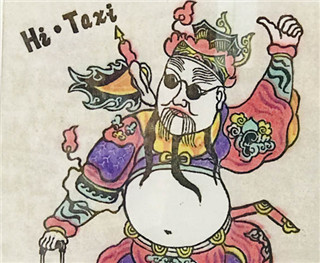Millennium-old folk art attracts new following
 0 Comment(s)
0 Comment(s) Print
Print E-mail chinadaily.com.cn, November 28, 2019
E-mail chinadaily.com.cn, November 28, 2019
Neo-nianhua works, jointly created by young designers and nianhua artisans, were on display side-by-side with traditional nianhua pieces during the Conference on Nianhua's Inheritance and Development, held from Nov 23-24 in Weifang, East China's Shandong province. [Photo by Zhao Yuzhu/provided to chinadaily.com.cn]
Zhong Xinglin made a hard decision in early 2017— to quit working as a local news correspondent for the web edition of the People's Daily in Central China's Hunan province.
Truly taking pride in her six-year stint at the influential media website, however, Zhong, was beckoned by her true calling to join her father's endeavor to revive nianhua.
Nianhua, aka Chinese New Year pictures, are a type of chromatic woodblock prints that boast a long history dating back to the Western Han Dynasty (206 BC-AD 24).
Zhong's family has been engaged in the nianhua-making business for more than a century.
However, "as Chinese society evolves at breakneck speed, nianhua, a typical token of a traditional way of life, is losing ground in contemporary life. Now it's my turn to keep the old art and craft thriving in the 21st century," Zhong told the audience at the opening ceremony of a conference on Chinese New Year pictures' inheritance and development, held from Nov 23-24 in Weifang, East China's Shandong province.
Apart from honing her nianhua-making skills, the media-savvy artisan has since catapulted Tantou nianhua, a variety of the famed Chinese intangible cultural heritage in her home province of Hunan, to stardom among young consumers across the country.
Both traditional products and modern spinoffs from the Zhong family's nianhua studio have been selling like hot cakes on social media, such as WeChat and TikTok.
"A steadily-growing number of followers are not only willing to buy Tantou nianhua products but also to learn nianhua-making skills. For me, that is very encouraging," said Zhong. "I am very optimistic about the future of nianhua."
Tai Liping, a veteran nianhua artisan from Baoji, Northwest China's Shaanxi province, echoed Zhong's optimism at the seminar on nianhua creation and innovation.
"I firmly believe that nianhua will enjoy a rebirth, gaining a foothold in contemporary life," said the 68-year-old master, a national-level nianhua inheritor, better known as a guardian of Fengxiang nianhua, a local variety of the Chinese New Year woodblock prints in Shaanxi.
Tai's family has been practicing the folk art since the early Ming Dynasty (1368-1644). As the only surviving 20th-generation inheritor of the art and craft, Tai has spent decades re-creating hundreds of traditional nianhua woodblocks, strictly in accordance with vintage New Year prints he found.
"Inheritance comes before innovation. It is my mission in life to rescue and recover traditional motifs, patterns and techniques. I am not interested in innovation. I'd rather leave it to young people," Tai said.
But Tai is happy to see that his son Tai Gaoyang, daughter-in-law Wang Yixuan, and daughter Tai Gaodi, have all joined in to promote nianhua.
Gaoyang and Yixuan concentrate on creating new products based on traditional nianhua motifs, and then market and sell them through e-commerce and social media platforms.






Go to Forum >>0 Comment(s)